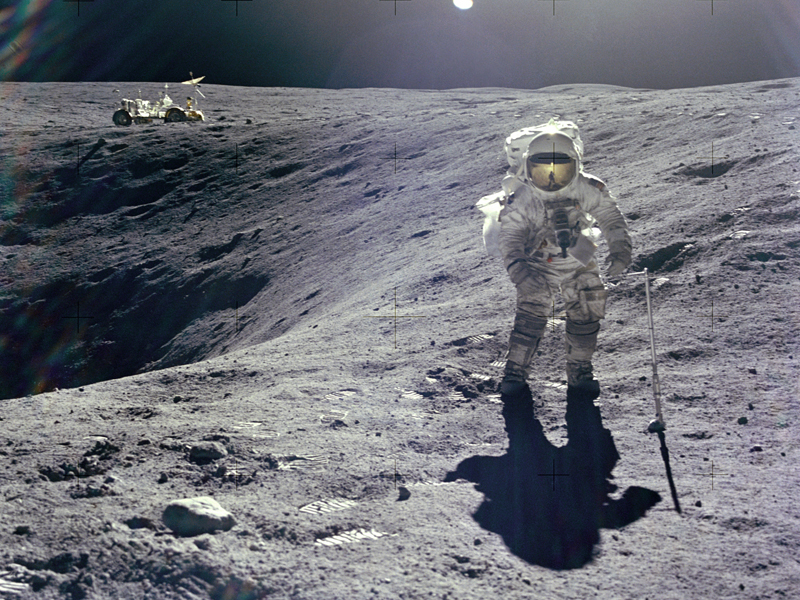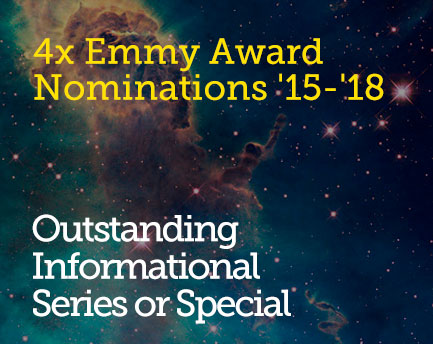January 29, 2013 6:21 pm
Meeting Charlie Duke, The Youngest Man to Walk on the Moon

Astronaut Charles M. Duke Jr., Apollo 16 Lunar Module pilot, is photographed collecting lunar samples at Station No. 1 during the mission’s first extravehicular activity at the Descartes landing site. This picture, looking eastward, was taken by Commander John W. Young. Duke is standing at the rim of Plum crater, which is 40 meters (131 feet) in diameter and 10 meters (about 33 feet) deep. The lunar rover can be seen in the background. Image credit: NASA
On January 13, 2013 StarTalk Radio’s Social Media Coordinator, Stacey David Severn, was in the audience at The Explorer’s Club in NYC for the Exploring Legends Interview Series session with General Charles M. Duke Jr., one of only 12 men to ever walk on the Moon. In this guest blog post, she shares her experience with us.
A few weeks ago, I decided to search the web for something memorable to do with my son while he was home on winter break. Since we’re both huge fans of space exploration, I Googled “astronaut appearances” to see what would come up. My timing was perfect! General Charles Duke, Apollo 16 astronaut and the youngest man to ever walk on the moon, was going to speak at the Explorer’s Club in New York City. I immediately bought tickets.
We rode in with a friend from our astronomy club and arrived early. Duke stepped out of a car in front of the Explorer’s Club, and we exchanged a warm greeting and shook hands before he went in. I was so happy!
Upon entering the front door, I felt humbled and awed. It looked a lot like Yale inside, with wood paneling, ornate carving, leaded glass, and a huge globe on the floor in the center of the landing. All around were reminders of the accomplishments of club members: a stuffed polar bear from the arctic, antique navigation tools, photos, sleds, and moon-flown flags. I was humbled to be in what I felt was a sacred space, worthy of greatness, and got all the more excited for what was to come.
General Duke came into our cocktail reception prior to the event, and graciously began telling stories. He talked about how Apollo 16’s landing was almost aborted due to a problem with the main engine in the service module, and about the photo of his smiling family that he left behind on the moon’s surface. I learned during cocktails that the temperature on the surface of that part of the moon was 230 degrees Fahrenheit, causing the plastic encased picture to shrivel, just after Duke shot the iconic photo of his family’s faces looking up at the camera from a bed of footprinted moon dust.
After cocktails we were seated for the interview. It was conducted by Explorer’s Club Fellow Jim Clash, an author and journalist whose accomplishments include visits to the North and South Poles, flying to the edge of space in a MiG fighter jet, driving at 253 mph in the Bugatti Veyron, climbing the Matterhorn peak, and surfing 3-story high waves in Hawaii. Jim already has a seat reserved on a Virgin Galactic space tourism flight.
Duke commented that he sees Richard Branson having success with Virgin Galactic and offered this advice to Jim: “Don’t even unstrap. Just stay in your seat and look out the window. The view out the window is going to be the most spectacular part of the whole thing. You’re going to see the curvature of the earth, the blackness of space, the deep blue of the oceans, and the brown of the land wherever you launch from.” After some thought he smiled and added, “Spend 3 minutes on the view, and two minutes floating around.”
Jim’s interview questions were brilliant and gave us, the audience, a chance to hear different and unusual tales about the mission, and lasting insights that were born as a result. We heard about (and saw footage of) the “Moon Olympics.” In light of Alan Shepherd’s Apollo 14 golf club swing, and since this launch coincided with the 1972 Munich Olympics, Duke and fellow moon walker John Young decided to hold their own Olympics on the moon. Doing the high jump, Duke got a little zealous. His 150-lb. backpack threw him off balance and he went over backwards. In the end, everything was okay, but a TV camera caught the incident. Mission Control was not too pleased, and the Moon Olympics ended. However, and he told us this with a smile, to this day Charlie Duke holds the high jump record on the moon!
As mentioned previously, the Apollo 16 moon landing almost didn’t happen. Asked how the crew felt, Duke said, “If your heart can sink to the bottom of your boots in zero gravity…ours did.” After a 6-hour delay, Duke and Young were given permission to land. They watched the shadow of the Lunar Module in the moon dust, which settled immediately because the moon has no atmosphere. Houston then changed the flight plan and told the two men to go to sleep before going out. “We agreed to that, we took off our suits and laid down, but can you IMAGINE trying to go to sleep?”
When they finally stepped outside, emotions were overwhelming. Duke was overcome with the beauty of the moon, landing in the highest elevation site of any of the Apollo missions. In their 3 days on the moon Duke and Young erected a US flag (complete with curtain rod to hold it out), collected rock samples, drove the lunar rover, performed experiments, and took photos. There was very little time to sit in wonder, but while working, these men experienced the beauty, texture, and color of the moon.
With dust everywhere, Duke instinctively tried to blow it off the camera but his helmet was a limiting factor. He also didn’t view the Earth much when he was on the moon, because from his position he had to look up to see it, but could only view the top of the inside of his helmet. However, all three astronauts were able to get spectacular views of our Earth from the ship.
Back aboard the Command/Service module (CSM), Ken Mattingly spent 3 days performing experiments before meeting up again with Duke and Young. On their way back to Earth, there was more work to be done. Mattingly and Duke had to go outside the ship for an EVA (spacewalk), to retrieve cameras from the outside of the CSM. This is one of my favorite stories of the evening.
It turns out that on Day 2 of the mission, Mattingly took off his wedding band when he was washing, and lost it in the weightlessness of the capsule. Now it’s Day 9. Lunar activity is over and Mattingly is outside the vehicle with Charlie Duke when Duke sees a glint in the hatch of the command module. The ring floats out the hatch into the blackness of space, where Duke takes a swipe at it and misses. The ring continues to float out into space, where it meets up with Mattingly at the far end of the service module, hits the back of his helmet, bounces backward 180 degrees, and hurtles through the blackness of space, making its way back toward the hatch…where Charlie Duke actually catches it! That’s a story you just don’t hear.
Other memorable moments aboard Apollo 16 included dealing with the laxative effects of drinking fortified Tang, and Mattingly’s idea to fill his helmet with water to see what would happen. (Don’t worry, he didn’t do it!)
When asked about UFO’s, Duke said that no Apollo program people ever saw anything, but he told his wife, “If I ever get picked up by a UFO, don’t expect me to come home.” He is the only astronaut of the opinion that there aren’t extra-terrestrial life forms, and for you sci-fi buffs, his favorite sci-fi movies are the three original Star Wars episodes.
Duke expressed his sadness at the end of the Shuttle program, and disappointment that the Constellation program was scrapped. He likes the idea of going to the moon and building a base as a rehearsal for going to Mars, and wants people to know that going to the moon was a good investment. After 40 years, he still gets excited about it. In Duke’s words, “Human spirit brings fulfilling activity in exploration.” That spirit is alive and well in Charles Duke and his fellow members of the Explorer’s Club. — Stacey David Severn
In case you’re interested, the Explorer’s Club Annual Dinner is March 16th, 2013. It is open to the public. We only mention it here because in addition to an “Exploring Legends” session with John Glenn (who is being honored along with Scott Carpenter, James Cameron and others), the keynote speaker of the evening is astrophysicist Neil deGrasse Tyson. Be warned: while tickets aren’t as expensive as the Business Insider IGNITION conference, they’re not as cheap as a StarTalk Live at the Bell House. These tix start at $375 and go up from there. You can find out more here.
That’s it for now. Keep Looking Up!
–Jeffrey Simons
Get the most out of StarTalk!
Ad-Free Audio Downloads
Ad-Free Video Episodes
Stickers & Mugs
Live Streams with Neil
Priority Cosmic Queries
Early-Access Videos
Learn the Meaning of Life
...and much more

 Become a Patron
Become a Patron

